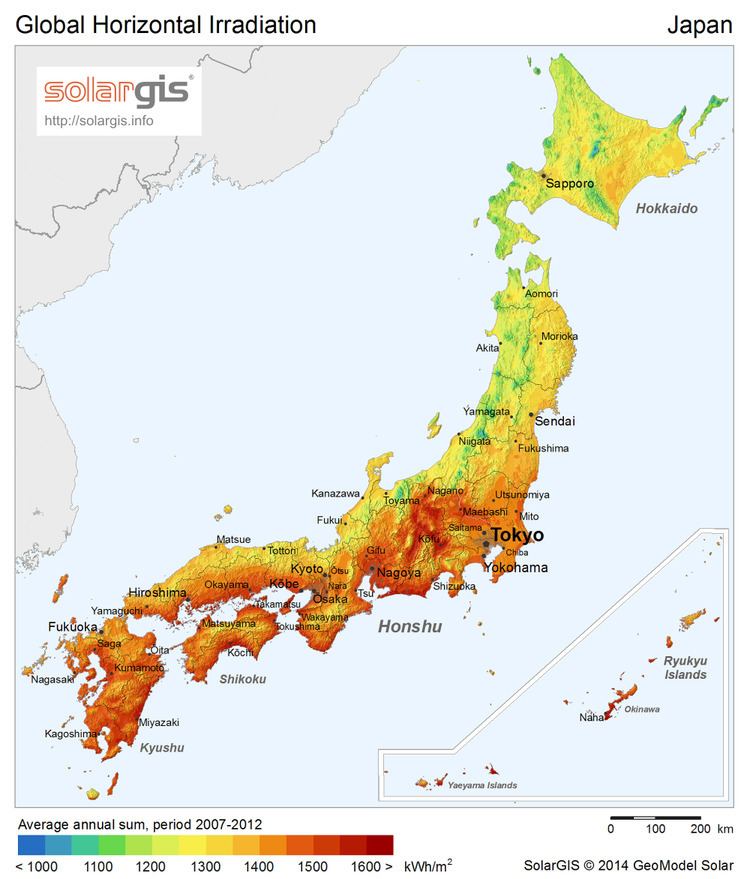 | ||
Solar power in Japan has been expanding since the late 1990s. The country is a leading manufacturer of photovoltaics (PV) and a large installer of domestic PV systems with most of them grid connected. The insolation is good at about 4.3 to 4.8 kWh/(m²·day). Japan is the world's fourth largest energy consumer, making solar power an important national project since the country's shift in policies toward renewables after Fukushima in 2011.
Contents
Japan was the world's second largest market for solar PV growth in 2013 and 2014, adding a record 6.97 GW and 9.74 GW of nominal nameplate capacity, respectively. By the end of 2015, cumulative capacity reached 34,150 MW, the world's third largest solar PV installed capacity, behind 1. China , 2.Germany and ahead of 4. USA 5. Italy and 6 UK . Overall installed capacity in 2015 was estimated to be sufficient to supply 3.5% of the nation's annual electricity demand.
Financial incentives
The Japanese government is seeking to expand solar power by enacting subsidies and a feed-in tariff (FIT). In December 2008, the Ministry of Economy, Trade and Industry announced a goal of 70% of new homes having solar power installed, and would be spending $145 million in the first quarter of 2009 to encourage home solar power. The government enacted a feed-in tariff on November, 2009 that requires utilities to purchase excess solar power sent to the grid by homes and businesses and pay twice the standard electricity rate for that power.
On June 18, 2012, a new feed-in tariff was approved, of 42 Yen/kWh, about 0.406 Euro/kWh or USD 0.534/kWh. The tariff covers the first ten years of excess generation for systems less than 10 kW, and generation for twenty years for systems over 10 kW. It became effective July 1, 2012. In 2013, Japan is expected to install 5-9 GW of solar power (nameplate wattage). In April 2013, the FIT was reduced to 37.8 Yen/kWh. The FIT was further reduced to 32 Yen/kWh in April 2014.
Targets
The government set solar PV targets in 2004 and revised them in 2009:
Companies
Solar companies of Japan include:
Notable projects
The Solar Ark, built in 2002, is one of the largest solar buildings in the world.
After the shift away from a nuclear power-dependent energy policy in the wake of the Fukushima nuclear accident, the first three solar plants by TEPCO were completed in 2011 and 2012, the Ukishima Solar Power Plant, 7 MW, the Ogishima Solar Power Plant, 13 MW, and the Komekurayama Solar Power Plant, 10 MW. The output of all three can be monitored on the internet.
341 MW of photovoltaics are planned for the island of Hokkaido, and a total of 1,800 MW of photovoltaics projects have been approved for Japan, as of October 2012.
Additional projects include the 70MW Kagoshima Nanatsujima Mega Solar Power Plant by Kyocera in Kagoshima Prefecture that went online in November 2013 and a 100 MW plant by Toshiba in Minami Soma, Fukushima Prefecture.
A 77 MW photovoltaic power plant is planned for Tahara City, on the Atsumi Peninsula, and is expected to be completed in 2014. A 200 MW plant is proposed for Tomakomai.
It is expected that many new projects will be constructed, to take advantage of the new feed-in tariff.
